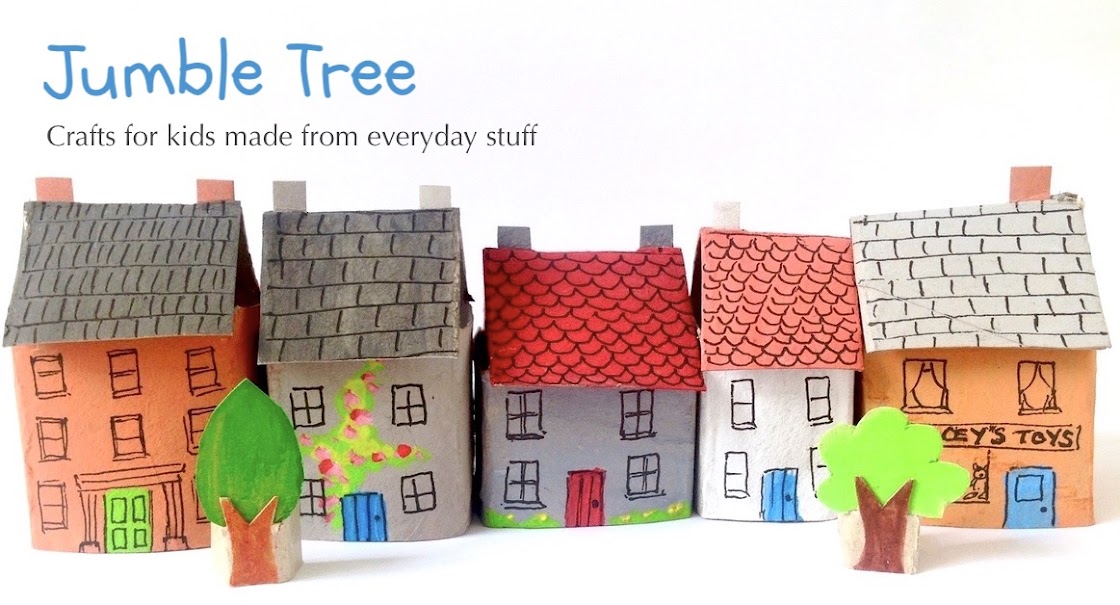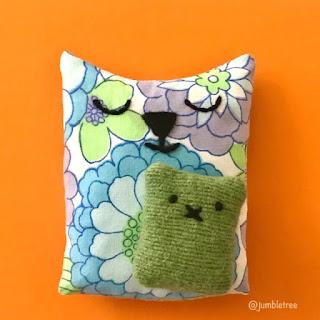It's something Trixi is truly passionate about, and each year she organises this worldwide Sew a Softie tutorial hop, with plenty of sewing inspiration from a gang of crafty bloggers EVERY DAY for a month.
I love hand sewing, and can still vividly remember some of the slightly strange things I made when I was little.. like a tiny green felt pony in a matchbox sized bed..
Honestly, I would still describe myself as an enthusiastic, experimental sewer, rather than a particularly accomplished one. But I do believe there's a great sense of joy and reward to be gained from diving in and having a sew, and seeing how much better you can get with a bit of practice. Something I hope I've passed onto my daughter.
Writing a tutorial with a pattern has meant I've had to think the whole process through in way more detail than I've done before, which has been an interesting learning experience!
And this tutorial does sort of fit in with my general crafty 'make do' message, as we've recently moved and I have had to make the most of what I've got here (not much..) So, very few pins! One colour of felt, no interfacing or embroidery thread.
But, if simply using what you can find around the house helps encourage a few more people to have a go, then that's got to be good thing, right?
For Sleepy cat and Teddy, you will need:
PDF pattern here
Fabric 8in.x 15in./20cmx40cm
Felt (for the tail) about 5in.x3in./13cmx8cm
Soft pencil (3b/4b/5b)
About 7in.x4in./18cmx10cm of an old wooly jumper (or piece of fabric/felt) for teddy
Pins
Needle and thread
Black (or brown) embroidery thread
OR yarn (this is what we used) and suitable needle
Button
1. Print out the PDF pattern on a sheet of A4, and cut out the three paper pieces.
Don't forget the hole where the button will go too.
4. Now, use a soft pencil and push it through the holes you've just made, pressing and twisting to make sure you mark the fabric. Remember the hole for placing the button.
OR use some black yarn (like we did), but because it'll probably be quite thick, don't double it up, just thread through and tie a knot at one end.
*KEEP CHECKING THAT YOU HAVEN'T PULLED THE STITCHES TOO TIGHT*
Hold onto the fabric and yarn where the first stitch is, and pull and gently tug the fabric and the rest of the stitches, until they lie flat and even. Make sure you do this before tying off the yarn underneath when you've finished the first eye (there's a quick video tutorial showing you how to finish off here)
Repeat for the other eye.
8. For the nose and mouth, have the paper pattern to hand.
*EASIER OPTION: For the nose, you could cut out a black felt triangle and stick in place with fabric glue.* Otherwise:
Thread the needle and knot the yarn and push the needle through the fabric from underneath, on the pencil line at point A* (have the pattern beside you so you can see the points)
Then back through at B, up through A and back through B. Then up through A* and across and back through A, to complete the triangle shape.
Again, keep checking the fabric hasn't gathered up and you haven't pulled the stitches too tight.
Now it's a case of filling in the triangle by stitching from one side to the other, passing the needle actually through, or as close to the two stitches that form either side of the triangle. Work your way down to the point.
All the time checking you haven't gathered the material by pulling the stitches too tight, and loosening them when you need to.
Again, keep checking the stitches aren't too tight. I know I keep banging on about this, but I promise it's worth the effort!
Tie off your thread underneath.
9. Sew the button on the front where the pencil mark is.
10. For the tail, use a soft pencil to draw around the template on some felt and cut it out. (If you can still see a few pencil marks just turn the tail over)
Pin to the right side of the back piece of the cat. Make sure it's about a cm or half an inch above the bottom edge.
11. Pin the two cat fabric pieces together, so the face and tail are facing inside, and the wrong sides are showing.
To help guide the seam sewing, use the soft pencil to draw a rough pencil line around the fabric shape, about a cm or so from the edge. Use the bottom of the tail as a marker for the line around the bottom of the cat.
12. Start about half way up one side - running stitch is the easiest ( double up your thread and knot the end so the thread doesn't keep slipping out of the needle). You will need to keep checking the stitches aren't too tight or too loose. Go around again if you feel the seam needs to be strengthened.
TIP: Don't make the thread too long, this will mean you'll need to tie off and re-thread as you sew around the shape, but that's less frustrating than tangles and knots..
We used back stitch (here's Trixi's video about how to seam using backstitch), which does take longer, but gives a stronger seam finish.
We used a ladder or slip stitch to close the hole, this is a little harder, but it does give a neat finish as the stitches are almost invisible. But if you prefer use overstitch
It's worth reminding kids to ask before they start chopping up jumpers.. I'm talking from experience here!
15. Fold your piece of jumper in half, pin the pattern to it and cut out. The stretchiness can make this a little tricky, but with such a simple shape it really won't matter if it's not perfect.
Finish 2cm/1in. or so from the start, turn inside out (using something to push out the corners). Add just a little stuffing before sewing the hole closed.
French knots are brilliant for eyes (Trixi has a video tutorial here)
But, if french knots are proving tricky, you could do two small stitches right next to each other for each eye instead. You'll be doing one in and out stitch with the needle, on the teddy front only, which is quite easy to do because it's stretchy. (See below)
18. Then feed the needle back towards the first eye, so it comes out just at the bottom of the eye and towards the middle for the nose/mouth (the X) Use the pattern piece as a guide.
Make a cross stitch here.
On the last stitch of the cross, take the needle through to the back of the teddy, bringing it off to a side and roughly halfway down. Make a knot here by making a little stitch, just through the surface, and thread your needle through the yarn loop before it closes. Don't pull tight until you've checked the face is okay and not stretched too tight.
Make another little stitch in line with the first one, near the other side of the teddy back. Don't tighten it until you're happy the yarn isn't too tight or too loose and, most importantly, will hook over the button on Sleepy Cat. Then, as you're pulling the thread through, pass the needle through the loop to fasten off again.
To get rid of the tail of thread, push the needle back through the teddy right next to the fastening off stitch, and out the side anywhere, pull tight, snip off the thread close to the body, and the tail should be hidden inside.


















































